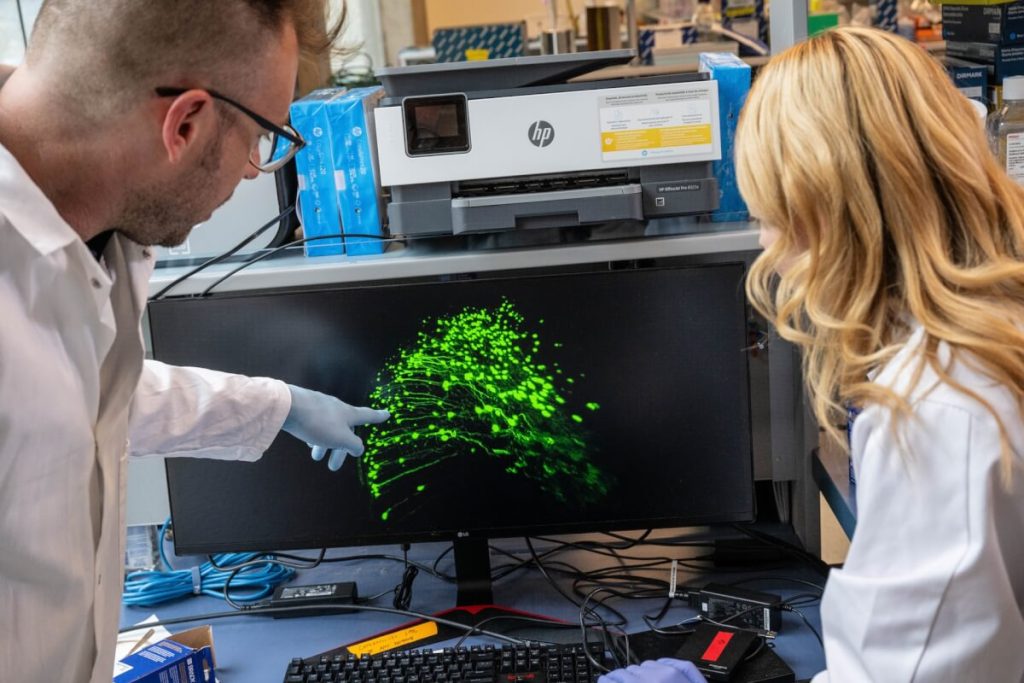

UBC associate professor of cellular and physiological sciences Dr. Mark Cembrowski (left) and PhD student Adrienne Kinman observe ovoid cells active in the hippocampus of a mouse. (Credit: Cembrowski Lab/UBC Faculty of Medicine)
VANCOUVER — From recognizing a friend’s face to finding our keys, our ability to remember objects shapes how we navigate daily life. But what’s behind this all-important mechanism that controls what we can remember and what we can’t? Scientists at the University of British Columbia have discovered unique brain cells responsible for these crucial memories, opening new possibilities for treating memory-related disorders.
“Object recognition memory is central to our identity and how we interact with the world,” explains Dr. Mark Cembrowski, the study’s senior author and associate professor at UBC, in a statement. “Knowing if an object is familiar or new can determine everything from survival to day-to-day functioning, and has huge implications for memory-related diseases and disorders.”
In their study published in Nature Communications, researchers identified an unusual type of brain cell they named “ovoid neurons” because of their oval, egg-like shape. These cells behave differently from other brain cells. They become very active when we see new objects but stay quiet when we encounter familiar ones.
The discovery came when Adrienne Kinman, a PhD student in Dr. Cembrowski’s lab and the study’s lead author, noticed something unusual while analyzing mouse brain samples. She spotted a small cluster of neurons with highly distinctive gene expression. “They were hiding right there in plain sight,” said Kinman. “And with further analysis, we saw that they are quite distinct from other neurons at a cellular and functional level, and in terms of their neural circuitry.”


Located in the hippocampus, a brain region vital for forming memories, these oval-shaped cells stand out from their pyramid-shaped neighbors. They form their own network, connecting to a specific brain region called the anterior thalamic nuclei.
To study these cells in action, the research team used a sophisticated technique that made the cells glow when active. Using a miniature microscope, they watched what happened in the mice’s brains as the animals explored new and familiar objects. When a mouse encountered a new object, these oval cells lit up brightly. But when the same mouse saw an object it had seen before, even months ago, these cells stayed quiet.
“What’s remarkable is how vividly these cells react when exposed to something new. It’s rare to witness such a clear link between cell activity and behavior,” Kinman noted. “And in mice, the cells can remember a single encounter with an object for months, which is an extraordinary level of sustained memory for these animals.”
To prove these cells were actually controlling object memory, the researchers used optogenetics, a technique that allows them to turn specific brain cells on or off using light. When they turned off the oval cells while mice were exploring new objects, the mice couldn’t form memories of these objects. However, this didn’t affect their ability to remember locations, showing these cells specifically handle object memory, not spatial memory.
In another fascinating experiment, turning these cells on made mice treat new objects as if they were familiar, essentially creating artificial memories. This worked even months after the mice had first seen an object, suggesting these cells help both form and maintain long-term memories of objects.
The research team is now investigating how these cells might be involved in conditions like Alzheimer’s disease and epilepsy. In Alzheimer’s, patients often struggle with recognition memory, forgetting what everyday objects are or failing to recognize photos of loved ones. The team hypothesizes that when ovoid cells become dysregulated, either too active or not active enough, they could drive symptoms of these conditions.
The study could eventually lead to better treatments for such memory disorders. By understanding exactly which brain cells handle different aspects of memory, scientists might be able to develop more targeted treatments for conditions that affect memory.
Sharpen your Memory! Play StudyFinds’ brand new game, WhizzyWords!
Paper Summary
Methodology
The researchers combined several cutting-edge techniques in their study. They first analyzed individual brain cells to identify unique genetic signatures, leading to the discovery of ovoid neurons. They then created specialized mice whose ovoid cells would glow when active. Using sophisticated microscopes, they observed these cells as mice explored objects. They also used light-sensitive proteins to control these cells, allowing them to turn them on and off at will.
Results
The study revealed several important findings. The oval neurons are distinctly different from other brain cells in their shape, genetics, and connections. They respond specifically to new objects and keep track of which objects are familiar. Turning these cells off prevents mice from remembering objects, but doesn’t affect their memory of places. Turning these cells on can make mice treat new objects as if they’ve seen them before.
Limitations
While this research is exciting, it has some limitations. The study was done in mice, so more research is needed to confirm whether human brains work the same way. The researchers only looked at how these cells handle object recognition, not other types of memory. They also haven’t mapped out all the brain circuits these cells connect to.
Key Takeaways
This research shows that different types of memories are handled by different types of brain cells. This challenges the previous understanding that the hippocampus processed all types of memory in the same way. The findings could lead to new approaches for treating memory disorders by targeting specific types of brain cells.
Funding and Disclosures
This work was funded by several organizations, including the University of British Columbia, the Natural Sciences and Engineering Research Council of Canada, the Canadian Institutes of Health Research, and the Howard Hughes Medical Institute. The researchers declared no conflicts of interest.
Publication Details
The study, “Atypical hippocampal excitatory neurons express and govern object memory,” was published in Nature Communications in February 2025 (Volume 16, Article number 1195).







